Page 318 of 395
L36 Engine Accessory Belt
The L36 engine uses an engine accessory belt. This
diagram shows the features connected and the routing.
See “Maintenance Schedule” in the Index for when to
check the belt.
B
F
A-
C
A. Power Steering
B. Generator C.
Air Conditioning
D. Crank
E. Coolant Pump
E Idler
L67 Engine Accessory Belt
The Supercharged 3800 (L67) engine uses two accessory drive belts. The inner belt drives the
generator, power steering pump, coolant pump and
air
conditioning. The outer belt drives the supercharger.
Each belt has its own tensioner and idler pulley. See “Maintenance Schedule” in the Index for when to check
the accessory
drive belts and the supercharger oil level.
Have your dealer check the
oil level in the supercharger.
F
1. Front Belt C. Crank
2. Back Belt D. Supercharger
A. Generator E. Coolant Pump
B. Power Steering Pump E Air Conditioning
Page 320 of 395
Section 7 Maintenance Schedule
This section covers the maintenance required for your Pontiac. Your vehicle needs these services to retain its safety,
dependability
and emission control performance.
7-2
7-4
7-3
1
Introduction
Part
A: Scheduled Maintenance Services
Part
B: Owner Checks and Services
7-35 Part C: Periodic Maintenance Inspections
I 7-37 Part D: Recommended Fluids and Lubricants
7-39 Part E: Maintenance Record
Page 322 of 395
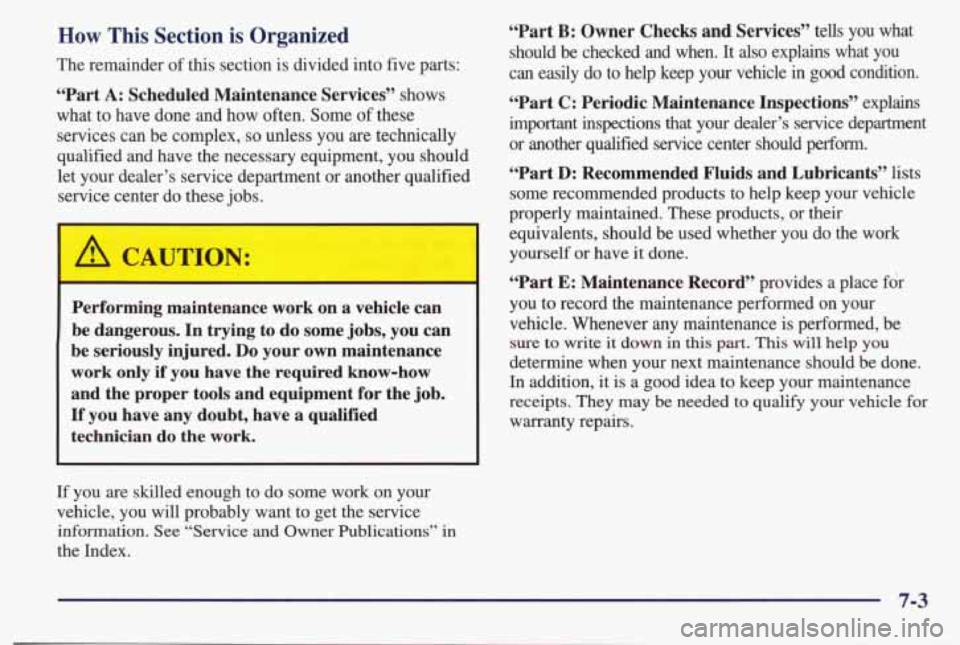
How This Section is Organized
The remainder of this section is divided into five parts:
“Part A: Scheduled Maintenance Services” shows
what to have done and how often. Some
of these
services can be complex,
so unless you are technically
qualified and have the necessary equipment, you should
let your dealer’s service department or another qualified
service center do these jobs.
A CAUTION:
I
Performing maintenance work on a vehicle can
be dangerous. In trying to
do some jobs, you can
be seriously injured.
Do your own maintenance
work only
if you have the required know-how
and the proper tools and equipment for the job.
If you have any doubt, have a qualified
technician do the work.
If you are skilled enough to do some work on your
vehicle, you will probably want to get the service
information. See “Service and Owner Publications”
in
the Index.
“Part B: Owner Checks and Services” tells you what
should be checked and when. It
also explains what you
can easily do to help keep your vehicle in
good condition.
“Part C: Periodic Maintenance Inspections” explains
important inspections that your dealer’s service department
or another qualified service center should
perform.
“Part D: Recommended Fluids and Lubricants” lists
some recommended products to help keep your vehicle
properly maintained. These products, or their equivalents, should be used whether you do the work
yourself or have it done.
“Part E: Maintenance Record” provides a place for
you to record the maintenance performed on your
vehicle. Whenever any maintenance is performed, be
sure
to write it down in this part. This will help you
determine when your next maintenance should be done.
In addition, it is
a good idea to keep your maintenance
receipts. They may be needed
to qualify your vehicle for
warranty repairs.
7-3
Page 323 of 395
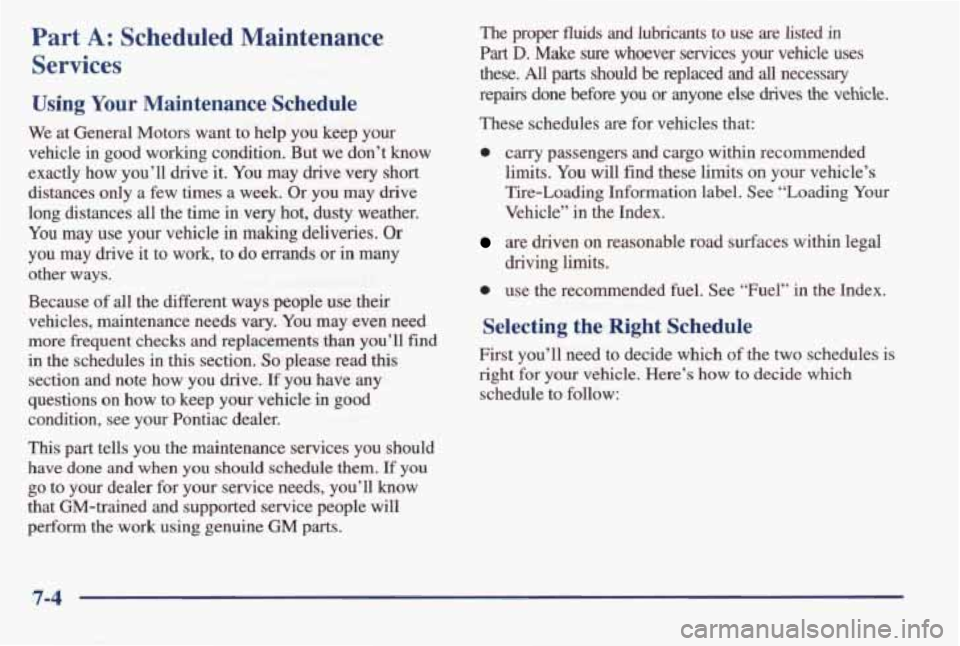
Part A: Scheduled Maintenance
Services
Using Your Maintenance Schedule
We at General Motors want to help you keep your
vehicle in good working condition. But we don’t know
exactly how you’ll drive it. You may drive very short
distances only a few times a week.
Or you may drive
long distances all the time in very hot, dusty weather.
You
may use your vehicle in making deliveries. Or
you may drive it to work, to do errands or in many
other ways.
Because
of all the different ways people use their
vehicles, maintenance needs vary. You may even need
more frequent checks and replacements than you’ll find
in the schedules in this section. So please read this
section and note how you drive. If you have any
questions on how to keep your vehicle in good
condition, see your Pontiac dealer.
This part tells you the maintenance services you should
have done and when you should schedule them. If you
go to your dealer for your service needs, you’ll know
that GM-trained
and supported service people will
perform the work using genuine GM parts.
The proper fluids and lubricants to use are listed in
Part D. Make sure whoever services your vehicle uses
these. All parts should be replaced and all necessary
repairs done before you or anyone else drives the vehicle.
These schedules are for vehicles that:
0 carry passengers and cargo within recommended
limits.
You will find these limits on your vehicle’s
Tire-Loading Information label. See “Loading Your
Vehicle’’ in the Index.
are driven on reasonable road surfaces within legal
driving
limits.
0 use the recommended fuel. See “Fuel” in the Index.
Selecting the Right Schedule
First you’ll need to decide which of the two schedules is
right for your vehicle. Here’s how
to decide which
schedule to follow:
7-4
Page 324 of 395
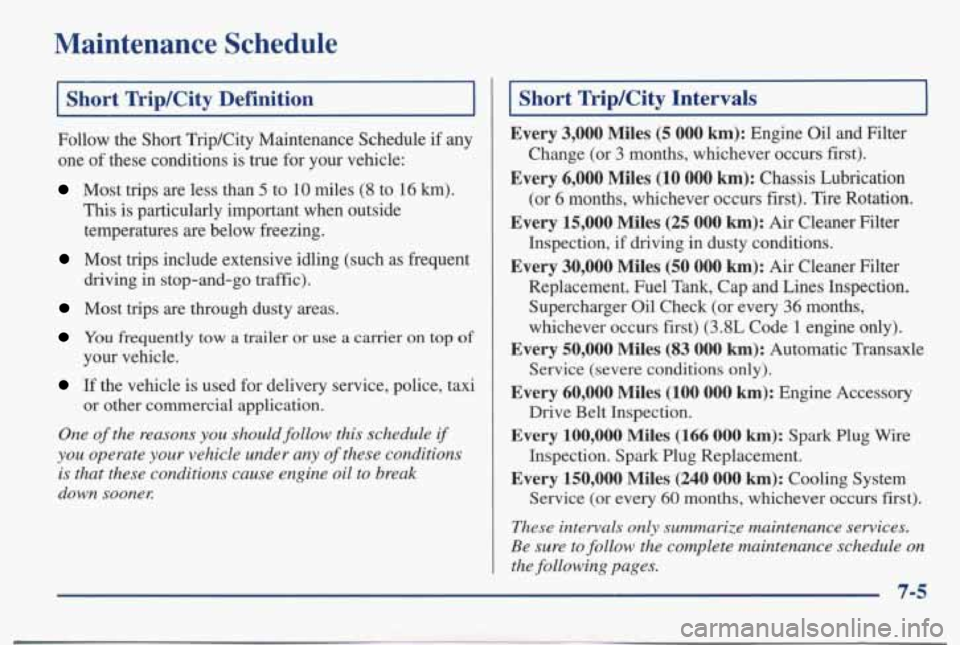
Maintenance Schedule
I Short TripKity Definition I
Follow the Short TripKity Maintenance Schedule if any
one
of these conditions is true for your vehicle:
Most trips are less than 5 to 10 miles (8 to 16 km).
This is particularly important when outside
temperatures are below freezing.
Most trips include extensive idling (such as frequent
driving in stop-and-go traffic).
Most trips are through dusty areas.
You frequently tow a trailer or use a carrier on top of
If the vehicle is used for delivery service, police, taxi
your vehicle.
or other commercial application.
One of the reasons you should follow this schedule if
you operate your vehicle under any of these conditions
is that these conditions cause engine oil to break
down soonex
Short Trip/City Intervals
Every 3,000 Miles (5 000 km): Engine Oil and Filter
Every 6,000 Miles (10 000 km): Chassis Lubrication
Every 15,000 Miles (25 000 km): Air Cleaner Filter
Every 30,000 Miles (50 000 km): Air Cleaner Filter
Change (or
3 months, whichever occurs first).
(or 6 months, whichever occurs first). Tire Rotation.
Inspection, if driving in dusty conditions.
Replacement. Fuel Tank, Cap and Lines Inspection.
Supercharger Oil Check (or every
36 months,
whichever occurs first)
(3.8L Code 1 engine only).
Every 50,000 Miles (83 000 km): Automatic Transaxle
Service
(severe conditions only).
Every 60,000 Miles (100 000 km): Engine Accessory
Drive Belt Inspection.
Every 100,000 Miles (166 000 km): Spark Plug Wire
Inspection. Spark Plug Replacement.
Every 150,000 Miles (240 000 km): Cooling System
Service (or
every 60 months, whichever occurs first).
These intervals only summarize maintenance services.
Be sure to follow the complete maintenance schedule on
the following pages.
RP
Page 325 of 395
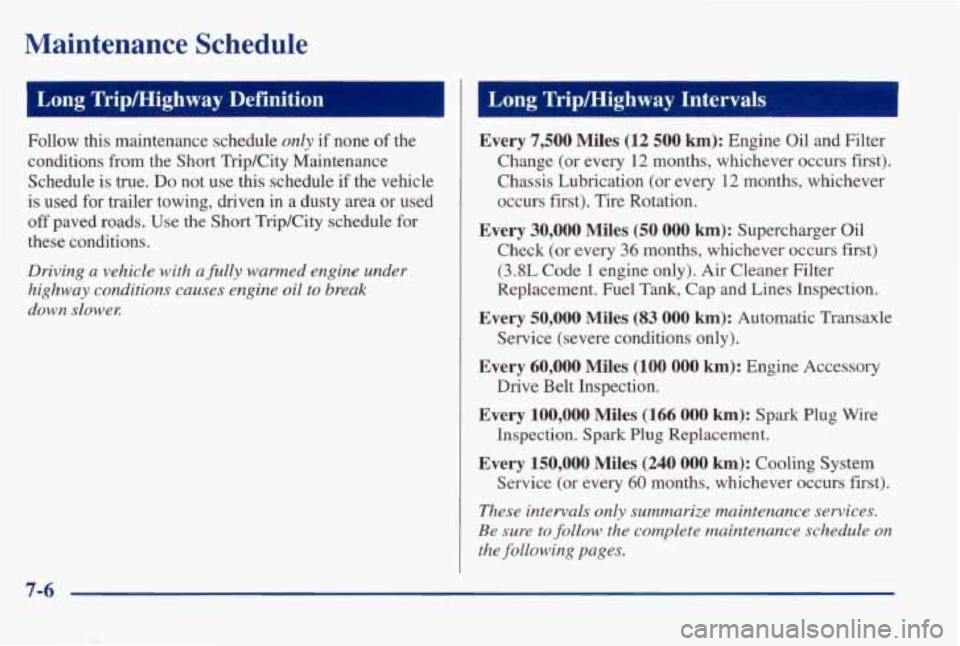
Maintenance Schedule
I Long TripMighway Definition
Follow this maintenance schedule only if none of the
conditions from the Short TripKity Maintenance
Schedule is true.
Do not use this schedule if the vehicle
is used for trailer towing, driven in a dusty area or used
off paved roads, Use the Short TripKity schedule for
these conditions.
Driving a vehicle with a filly warmed engine under
highway conditions causes engine
oil to break
down slower:
~ ~~~~
I Long TripMighway. Intervals
Every 7,500 Miles (12 500 km): Engine Oil and Filter
Change (or every
12 months, whichever occurs first).
Chassis Lubrication (or every
12 months, whichever
occurs first). Tire Rotation.
Every 30,000 Miles (50 OOO km): Supercharger Oil
Check (or every
36 months, whichever occurs first)
(3.8L Code 1 engine only). Air Cleaner Filter
Replacement. Fuel Tank, Cap and Lines Inspection.
Every 50,000 Miles (83 OOO km): Automatic Transaxle
Every 60,000 Miles (100 000 km): Engine Accessory
Service (severe conditions only).
Drive Belt Inspection.
Every 100,000 Miles (166 000 km): Spark Plug Wire
Inspection. Spark Plug Replacement.
Every 150,000 Miles (240 000 km): Cooling System
Service (or every 60 months, whichever occurs fist).
These intervals only summarize maintenance services.
Be sure to follow the complete maintenance schedule on
the following pages.
Page 326 of 395
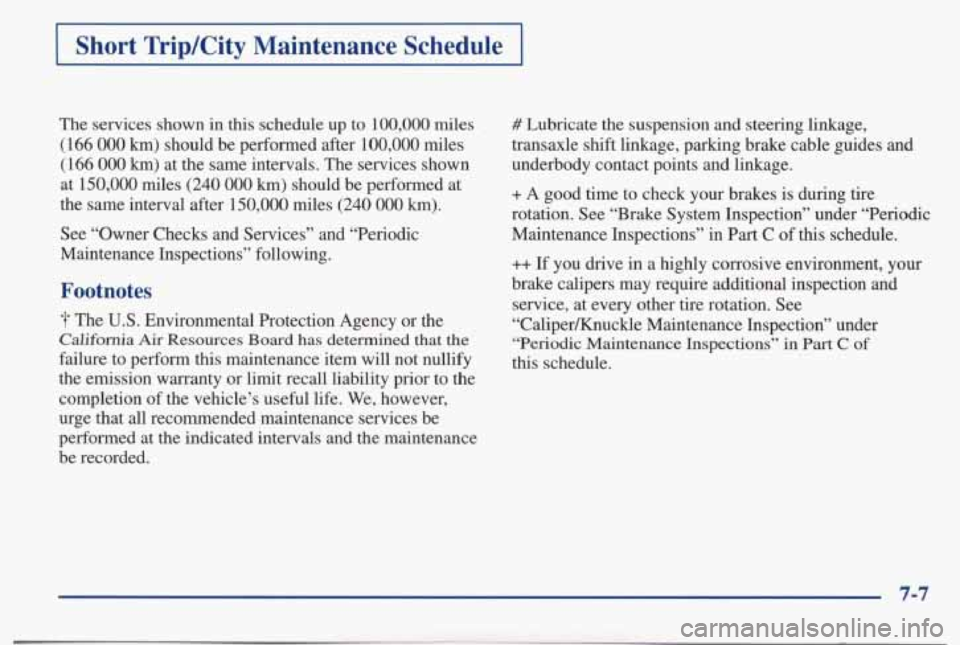
Short TripKity Maintenance Schedule .
The services shown in this schedule up to 100,000 miles
(166
000 km) should be performed after 100,000 miles
(166
000 km) at the same intervals. The services shown
at
150,000 miles (240 000 km) should be performed at
the same interval after
150,000 miles (240 000 km).
See “Owner Checks and Services’’ and “Periodic
Maintenance Inspections” following.
Footnotes
The U.S. Environmental Protection Agency or the
California Air Resources Board has determined that the
failure to perform this maintenance item will not nullify
the emission warranty or limit recall liability prior to the
completion of the vehicle’s useful life. We, however,
urge that
all recommended maintenance services be
performed at the indicated intervals and the maintenance
be recorded.
# Lubricate the suspension and steering linkage,
transaxle shift linkage, parking brake cable guides and underbody contact points and linkage.
+ A good time to check your brakes is during tire
rotation. See “Brake System Inspection” under “Periodic
Maintenance Inspections” in
Part C of this schedule.
++ If you drive in a highly corrosive environment, your
brake calipers may require additional inspection and service, at every other tire rotation. See
“CaliperKnuckle Maintenance Inspection” under
“Periodic Maintenance Inspections”
in Part C of
this schedule.
7-7
Page 327 of 395
1 Short TripKity Maintenance Schedule
3,000 Miles (5 000 km)
0 Change engine oil and filter (or every 3 months, whichever occurs fist).
An Emission Control Service.
6,000 Miles (10 000 km)
0 Change engine oil and filter (or every 3 months, whichever occurs fist).
0 Lubricate chassis components (or every 6 months, whichever occurs first).
0 Rotate tires. See “Tire Inspection and Rotation” in the Index for proper
An Emission Control Service.
(See footnote #.)
rotation pattern and additional information. (See footnote +.)
9,000 Miles (15 000 km)
0 Change engine oil and filter (or every 3 months, whichever occurs fist).
An Emission Control Service.
12,000 Miles (20 000 km)
0 Change engine oil and fiter (or every 3 months, whichever occurs first).
An Emission Control Service.
I DATE I
I I I
I DATE I
I DATE I
DATE I
I MILEAGE ACTUAL I SERVICEDBY: I
7-8